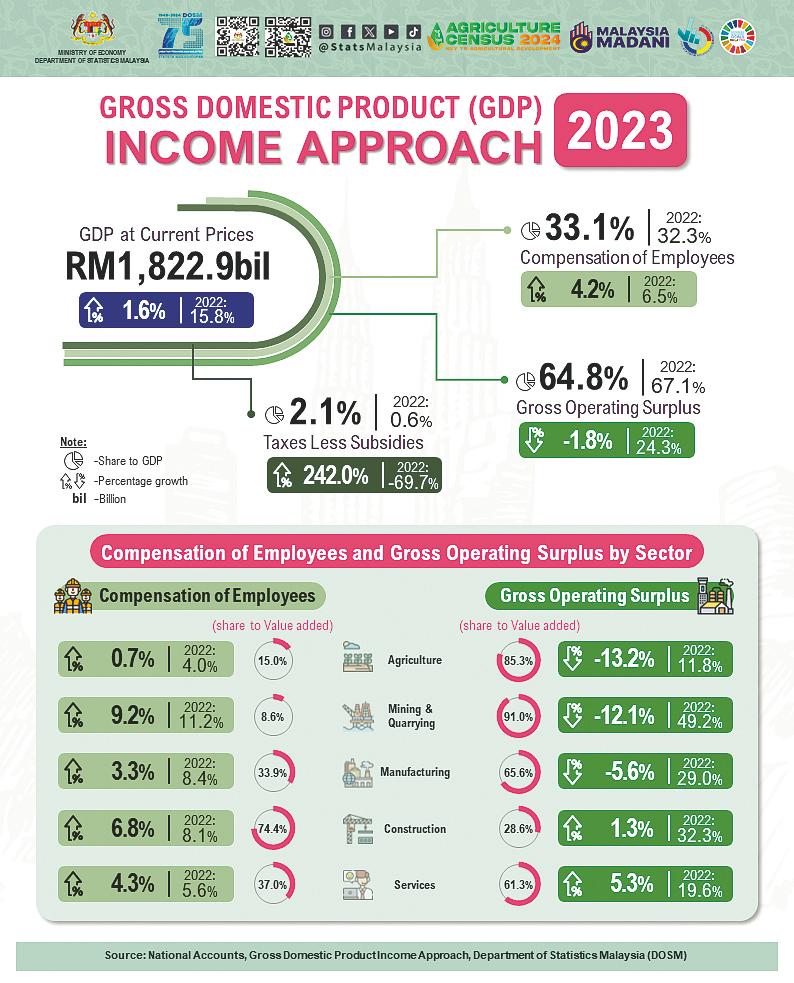PETALING JAYA: Malaysia’s nominal gross domestic product (GDP) amounted to RM1.8 trillion in 2023, growing 1.6% compared to 15.8% in the previous year, Chief Statistician Malaysia Datuk Seri Dr Mohd Uzir Mahidin said today.
Despite the moderated performance, he said, the economy remained resilient particularly through private final consumption expenditure that increased 6.7%. The growth, he added, was propelled by ongoing enhancement in employment and wage through the implementation of new minimum wage of RM1,500 a month which started in May 2023.
Given the improvements in the labour market, compensation of employees (CE) recorded a steady growth of 4.2% while gross operating surplus (GOS) declined by 1.8%. The performance of the income distribution showed a shift towards a better share of CE at 33.1% compared to 32.3% in 2022, Mohd Uzir said.
Nevertheless, GOS still contributed substantially to GDP at 64.8% although it was 2.3% lower than the previous year. The remaining component was taxes less subsidies on production and imports (net taxes), which accounted for 2.1%.
Looking at detailed sectoral performance, the increase in the CE component, encompassing the remuneration received by employees for their labour was driven by the services, manufacturing and construction sectors. CE in services sector grew 4.3%, supported by growth in all sub-sectors, particularly wholesale and retail trade, food & beverages and accommodation.
The manufacturing sector CE registered 3.3% growth, led by the moderation in electrical, electronic and optical products. Furthermore, CE in construction and mining & quarrying sectors rose 6.8% and 9.2%, respectively, while CE in agriculture sector showed a marginal increase of 0.7% in 2023.
The services sector was the largest contributor to the CE, represented 62.5%, followed by the manufacturing sector with 23.6% share. Collectively, these sectors made up 86.1% of overall CE, reflecting a significant role in the economy.
While, the construction and agriculture sectors accounted for 8.1% and 3.5%, respectively. The mining & quarrying sector contributed the smallest share, 2.2% of total CE.
Mohd Uzir said the decline in GOS was primarily influenced by a sharp downturn in mining & quarrying (-12.1%), agriculture (-13.2%) and manufacturing (-5.6%) sectors.
The fall of commodity prices in 2023 has lowered profitability across these sectors, leading to a marked decrease in overall GOS. Nevertheless, the contraction was partially alleviated by the growth in the services and construction sectors at 5.3% and 1.3%, respectively.
In terms of composition of GOS, the services sector led with a 52.9% share, followed by the manufacturing sector at 23.3%. The mining & quarrying and agriculture sectors made up 12.0% and 10.2%, respectively. Meanwhile, the construction sector accounted for 1.6% of GOS in 2023.
Net taxes, a component which represents the source of income for the government, showed remarkable growth of 242% or RM37.7 billion in 2023, attributed to the higher taxation revenue as compared to a decrease in subsidies.
Taxes on production and imports increased by 3.1%, driven by the growth in services tax and import duty. Meanwhile, a significant drop in subsidies, at 34.2% was mainly influenced by the decline in petroleum and diesel subsidies.
In the context of international comparison, the composition of CE in the Southeast Asian region is notably lower, accounting for less than 40% of GDP, while GOS makes up a larger share.









